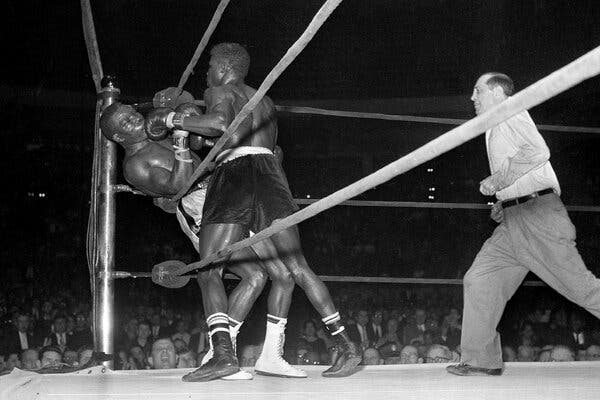Emile Griffith fought Benny Paret on March 24, 1962, in a highly anticipated welterweight championship bout at Madison Square Garden.
In the 12th round, Griffith knocked Paret into the ropes and pounded him with more than a dozen unanswered blows. As The New York Times put it the next day, “The only reason Paret still was on his feet was that Griffith’s pile-driving fists were keeping him there, pinned against the post.”
Paret never regained consciousness and died 10 days later. The fight and its terrible aftermath were high drama. One might even call the story operatic.
There has been little overlap between the high drama of sports and the high drama of opera, beyond the bullfighting in “Carmen” or perhaps that odd singing competition in “Die Meistersinger von Nürnberg.” But in telling Griffith’s story, Terence Blanchard and Michael Cristofer’s 2013 opera “Champion,” which opened earlier this month at the Metropolitan Opera and streams live in movie theaters on Saturday, brings together the brutality of boxing with the soaring passions of opera.
It helps that “Champion” is not just a tale of boxing, but also of Griffith’s life as a closeted gay man, an immigrant with a tough childhood and complicated relationship with his mother, and later an old age troubled by dementia and regret.
But boxing is the catalyst for the story. The 1962 bout was the third between Griffith and Paret, who had split their first two fights. (Those earlier contests are omitted from the opera, keeping the focus on the fateful third.)
It was a time when big boxing matches were big news. Pre-fight hype was everywhere, with all aspects of the fighters’ preparations scrutinized. The Times marveled at Griffith’s “$130 a day suite with two television sets and a closet the size of a Y.M.C.A. room” in Monticello, N.Y., as well as the “turtleneck sweaters, seal coats and Ottoman club chairs” that surrounded the ring as he sparred.
The terrible aftermath of the fight brought even more intense coverage. News of Paret’s serious condition made the front page of The Times, days after the fight, with the headline “Paret, Hurt in Ring, Given Little Chance.”
At the time, the biggest controversy was the referee’s delay in stopping the contest. “Many in the crowd of 7,500 were begging” the referee to intervene, The Times reported. The referee, Ruby Goldstein, was later exonerated by the State Athletic Commission.
But there was more to the story. Though Griffith said he was “sorry it happened,” he added, “You know, he called me bad names during the weigh-in” and during the fight, “He did it again, and I was burning mad.”
“Bad names” was how Griffith, The Times and other newspapers described Paret’s taunts. The true nature of those words was not widely known at the time. But in the mid-2000s Griffith revealed the full story. Paret had called Griffith “maricón,” a Spanish slur for a gay man. Griffith was secretly bisexual.
The opera’s second act deals with the fallout from the fatal punches, and Griffith’s later life, including a brutal beating he received outside a gay bar. Griffith died in 2013 at 75.
The Met worked hard to get the details and the atmosphere of a prize fight right: the ring announcer (who acts here as a Greek chorus of sorts), the sound of the bell, the trophies and championship belts, a “ring girl” signaling the changing of the rounds and the macho posturing of the weigh-in. (The conductor Yannick Nézet-Séguin emerges in the pit for the second act in a boxer’s hooded robe.)
Helping to make it look accurate was Michael Bentt, a former professional world champion who served as the opera’s boxing consultant. “I’m not an expert on opera,” he said. “But I’m an expert on rhythm. And boxing is rhythm.”
Bentt told the production team that there should be no stool in the ring before the first round, only between later rounds. And he thought that the boxing mitts, used by a trainer to block a fighter’s punches, looked too clean. “I said: ‘Make them look gritty. Rub them on the concrete to get them nasty looking.’ There’s nothing clean about the world of boxing.”
The Met’s fight director, Chris Dumont, is used to working out sword fights. But for “Champion,” he had to choreograph fisticuffs and make them look convincing without anyone getting hurt.
“For the body shots, they might make some contact with each other,” he said. “But you don’t want someone to get hit in the face. Even if it’s light, it won’t feel too good.”
There are several ways to depict boxing: One is to simulate it as closely as possible, as some boxing movies do, by showing powerful punching and splattering blood. A more apt choice for the stage is stylization.
“Since they have to sing, actually boxing through those scenes would wind them,” Dumont said of Ryan Speedo Green, who portrays the younger Griffith, and Eric Greene, who plays Paret. Most of the time, when a blow lands, the singers freeze, as if in a snapshot. Some parts are performed in slow motion.
The show reaches its sporting peak with the re-creation of the 1962 fight, which ends the first act. The tension and anticipation operagoers may feel as the ring appears onstage is not all that different from the mood among fight fans or sportswriters in the moments before a big bout. All sports have some atmosphere of pregame expectation. But when the sport involves two combatants trying to hurt each other with repeated blows to the head, there is an added frisson of fear, or even dread.
In “Champion,” Griffith goes down in the sixth round, and the shouts of a boisterous onstage crowd add to the tension. Then comes the fatal moment.
Although the boxers’ blows onstage do not land, that does little to temper the grim moment when a flurry of unanswered shots floor Paret. “I watched the actual fight and tried to keep it as real as possible,” Dumont said. “The 17 blows are fairly close to what it was, in real time. We are not actually landing blows, but moving fast enough so the audience is tricked. It moves back to slow motion as he is falling to the mat.”
And in the orchestra pit, the snare drummer looks up at the stage. Each time a blow falls, he raps a synced snare shot.
A night at the opera can bring murder or war or bloodshed. But the historically and sportingly accurate depiction of a prize fight that ended with a man’s death has an unsettling quality all its own. As Goldstein, the referee, testified: “It’s the type of sport it is. Death is a tragedy that occasionally will happen.” Or, as Bentt said of “Champion,” “We can’t tiptoe around that it’s violence.”
Visits: 0










